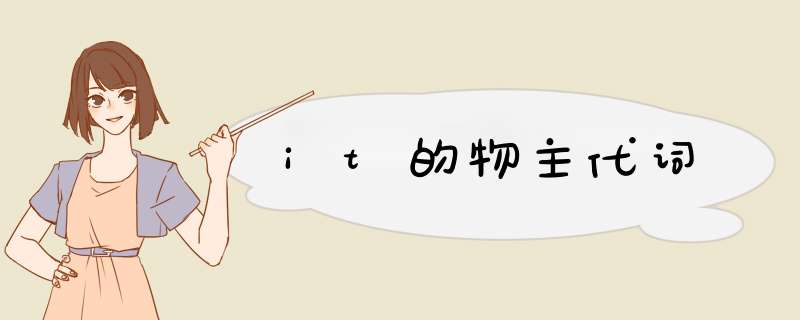
你老师说错了,一般是表示爱憎感情类的动词如like, love, dislike, hate, enjoy或appreciate, see to, depend/rely on等加宾语从句时,先加it做形式宾语,而把宾语从句后置
宾语从句的引导词一般有三种:that, if和when
It的用法(专项总结)
一、人称代词
1,it的最基本用法是作代词,主要指刚提到的事物,以避免重复:
①They watched the train until it disappeared in the distance
2,也可以指动物或婴儿(未知性别的婴儿或孩子):
②Is this your dog?No, it isn’t
③They got a baby and it was a ten-pounder
3,也可指抽象事物或指抽象环境和情景:
③I hate it when people talk with a full mouth.
二、非人称代词
1it有时并不指具体的东西而泛指天气、时间、日期、距离、价值、度量、温度、环境等:
⑴指天气:It is a lovely day, isn’t it ⑵指时间: It was nearly midnight when she came back
⑶指日期:It is April First today ⑷指距离:It is some 3000 kilometers from A to B
⑸指价值:It is three dollars ⑹指温度:Today it is 30 degrees centigrade
三、其他用法
1在句子的主语不太明确时充当主语,表示谁在做某事:
①Who is it there It's I (me/you/he) ②I thought it was Mary, but it was not she
③Her face lighted when she saw who it was
2泛泛的指某件事: (有时泛指一般情况)
①It doesn’t matter ②It is a shame, isn’t it ③How is it going(情况怎样)
④It says in the newspaper that
3it用在一些词组中,it 没有特别的意思
The last train's gone Come on, we'll foot it(来,咱们步行吧。)
四、作形式主语,替代主语从句,动词不定式,或动名词短语:
1作形式主语替代主语从句
⑴It is clear ( obvious, true, possible, certain) that 从句 常译为"┅清楚的(显然的,真的,可能的,肯定的...)"
It is very clear that he’s round and tall like a tree = That he’s round and tall like a tree is very clear
⑵It is important ( necessary, right, strange, natural) that 从句 常译为┅是重要的(必要的,对的,奇怪的,自然的┅)that 后的从句中要用虚拟语气(should + 动词原形),should 可以省去,建议记住该句型中的形容词。
①It is important that we (should) learn English well②It is necessary that he (should) remember these words
⑶It is said (reported/ learned/believed/thought/known/told/hoped) that 从句 常译为"据说(据报道,据悉...)"。
①It is said that he has come to Beijing ②It is reported that another earth satellite has been put into orbit
⑷It is suggested ( advised/ ordered / demanded/ insisted/ commanded ) that 从句that 后的从句要用虚拟语气(should + 动词原形),should 可以省;常译为"据建议;有命令...)
①It is suggested that the meeting ( should ) be put off
②It was ordered that we ( should ) arrive there in two hours
⑸It is time ( about time ,high time ) that从句(虚拟语气:动词用过去时did)
① It is time that children went to bed
⑹It is the first ( second ) time that从句(从句用现在完成时 have done )
It was …(从句用过去完成时had done )常译为"是第一(二)...次..."。
It is the first time I have been here = This is the first time I have been here
⑺It is a pity ( a shame /an honour/a good thing/a fact,/a surprise/ ) that从句
that后的从句一般用虚拟语气(should + 动词原形),should可省去.表示出乎意料,常译为"竟然"。没有这种意义时,则不用虚拟语气。
①It is a pity that such a thing ( should ) happen in your class 这种事竟然发生在你们班上,真是遗憾!
②It is a pity that he is ill 他生病了,真遗憾!
⑻It happens (seems, looks, appears ) that从句常译为 “ 碰巧…,似乎是…,看起来…”
①It happened ( so happened ) that he met his teacher in the street 碰巧..
②It seems that he will be back in a few days 看来...
2作形式主语替代不定式
⑴ It is kind ( of sb ) to do sth 不定式的逻辑主语是由 of引起,主句中的形容词必须是能表示逻辑主语特征的褒义或贬义形容词。 常见的词有:
bad , brave , careless, clever , cruel , foolish , good (好心的), honest , horrible , kind , lazy , modest , naughty , nice(有教养的), polite, rude , silly , stupid , wise , wrong(错误的)等。 这个句型可以改写为:sb is kind to do sth 。 如:It is kind of you to say so = You are kind to say so
⑵It is necessary ( for sb ) to do sth 不定式的逻辑主语是由for引起,主句中的形容词通常是表示重要性,紧迫性,频繁程度,难易,安全等情况的中性形容词。 常见的形容词有:
important, necessary, natural easy , safe , common , normal , hard , difficult , dangerous , unusual, rare , impossible , pleasant
如:It is important for her to come to the party = It is important that she (should ) come to the party
⑶It takes sb to do sth 常译为"做...要花费某人..."。
如:It took thousands of people many years to build the Great Wall
3作形式主语替代动名词短语
It is no good / no use / useless doing sth 常译为 “┅有好处或没有用”
①It is no good learning English without speaking English
②It's useless trying to argue with Shylock
五、作形式宾语,代替不定式,动名词短语或宾语从句。
We think it important to learn a foreign language
该句型中的it 作形式宾语,该结构中常用的动词有:think, believe, make ,find consider, feel; 如:
We think it our duty to clean our classroom every day
He felt it important learning English well
They found it difficult that they would finish their work in two days
The Internet makes it easier for companies to keep in touch with customers
CF: keep sth, in mind / keep in mind that
六、it的重要句型
1强调句型: It is/was + 被强调部分 + that 从句 (被强调的主语如果是人,that可以由who换用)
①It was about 600 years ago that the first clock with a face and an hour hand was made
②It was they that (who ) cleaned the classroom yesterday
特例:It is not until + 被强调部分 + that 该句型也是强调句型。主要用于强凋时间状语,译成汉语"直到...才...",可以说是 not until 的强调形式。
It was not until she took off her dark glasses that I realized she was a famous film star
it的物主代词是its,既是名词性物主代词表示“它的东西”,也是形容词性物主代词表示“它的”。
物主代词主要包括名词性物主代词和形容词性物主代词,名词性物主代词主要有:mine、yours、ours、theirs等。形容词性物主代词主要有:my、our、your等。
it是修饰名词,所以形容词所有格代词后面要跟宾语的名字,而名词所有格代词直接代表宾语的名字,所以后面不需要加名词,如果句子中出现的两个事物是同类的,那么后面的事物在讲述时可以省略。
物主代词的用法
要注意物主代词是有人称和数的变化,而且第三人称单数的物主代词还有性别的变化。形容词性物主代词主要有分为单数形式和复数形式,其中单数形式有:my(我的)、your(你的)、his(他的)、her(她的)、its(它的);复数形式主要有:our(我们的)、your(你们的)、their(他们的)。
名词性物主代词同样也分为单数形式和复数形式,其中单数形式主要有:mine(我的什么东西)、his(他的什么东西)、hers(他的什么东西)、its(它的什么东西)、yours(你的什么东西);复数形式主要有:ours(我们的什么东西)、yours(你们的什么东西)、their(他们的什么动词)。
以上就是关于后先跟it再加宾语从句的动词全部的内容,包括:后先跟it再加宾语从句的动词、英语it的用法、it的物主代词等相关内容解答,如果想了解更多相关内容,可以关注我们,你们的支持是我们更新的动力!
欢迎分享,转载请注明来源:内存溢出

 微信扫一扫
微信扫一扫
 支付宝扫一扫
支付宝扫一扫
评论列表(0条)